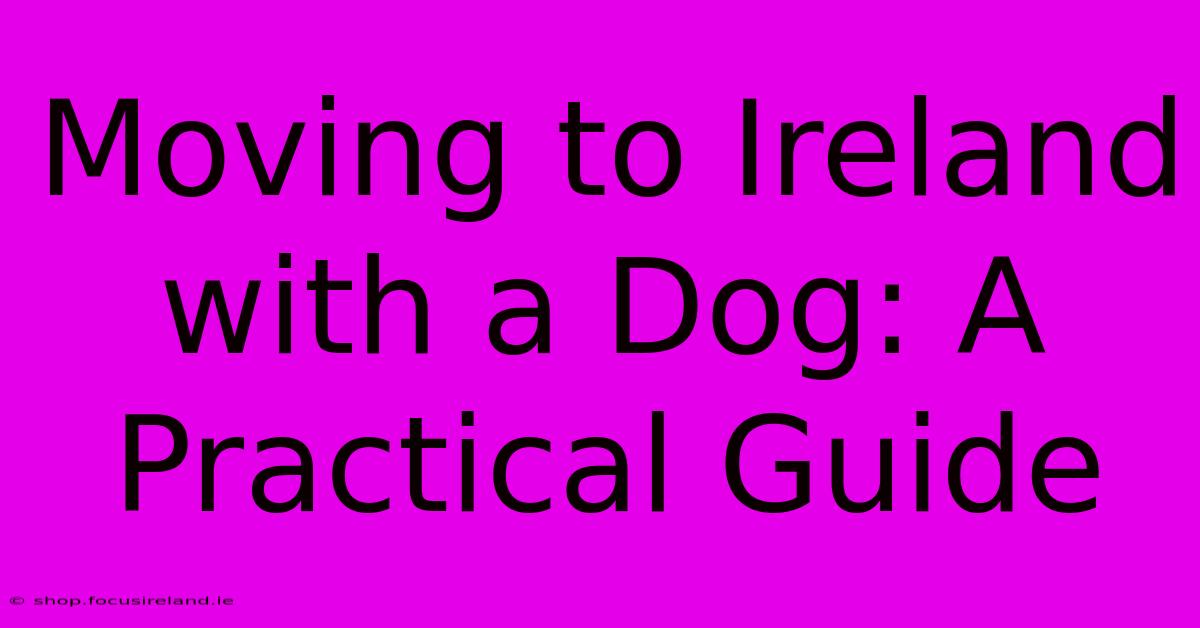Moving To Ireland With A Dog: A Practical Guide

Table of Contents
Moving to Ireland with a Dog: A Practical Guide
Dreaming of trading in your current life for the emerald isle? Bringing your beloved canine companion along makes the adventure even better! However, relocating with a dog to Ireland requires careful planning and adherence to specific regulations. This comprehensive guide will walk you through the essential steps, ensuring a smooth transition for both you and your furry friend.
Understanding Irish Pet Import Regulations
Before you even begin packing, understanding Ireland's pet import rules is paramount. Non-compliance can result in delays, quarantine, or even the heartbreaking return of your pet. The primary authority is the Department of Agriculture, Food and the Marine (DAFM). Their website is your best resource for the most up-to-date information, but here's a summary of key requirements:
Essential Documents:
-
Pet Passport or Animal Health Certificate (AHC): This is arguably the most crucial document. An AHC, issued by an official veterinarian in your country of origin, must be completed within 10 days of travel. It verifies your dog's health status and confirms it meets all necessary vaccination and treatment requirements. The specifics vary depending on your country of origin, so check the DAFM website for details relevant to your situation.
-
Microchip: Your dog must have a microchip compliant with ISO standard 11784 and 11785. This is essential for identification purposes.
-
Rabies Vaccination: Your dog needs a valid rabies vaccination. There's a waiting period after the vaccination before you can travel, so plan accordingly. This waiting period is crucial and is often a major factor in planning your move.
-
Tapeworm Treatment (if applicable): Depending on the country you are moving from, your dog might require tapeworm treatment administered by a vet within 5 days (or less) of travel to Ireland.
Transportation:
-
Direct Flights are Preferred: While not always possible, direct flights are generally recommended to minimize stress for your dog and reduce the risk of complications.
-
Approved Carriers: Ensure your chosen airline is authorized to transport pets and that their pet transport policies meet the necessary standards. You'll need to confirm booking specifics well in advance.
-
Suitable Travel Crate: Your dog needs a sturdy, appropriately sized crate for the journey. Airlines have specific crate requirements, which you must meet.
Life in Ireland with Your Dog: Practical Considerations
Successfully importing your dog is just the first step. Here’s what to consider once you’ve settled in:
Veterinary Care:
Finding a reputable veterinarian is crucial. Research local vets near your new home before you arrive. Ireland has a high standard of veterinary care, so you'll be able to find excellent options.
Dog Parks and Walking Areas:
Ireland boasts many beautiful parks and walking trails perfect for enjoying with your dog. However, always ensure your dog is on a lead unless in designated off-leash areas. Research local dog-friendly parks and beaches before exploring.
Dog Insurance:
Pet insurance is highly recommended. Unexpected veterinary bills can be substantial, so a good insurance plan will offer financial peace of mind.
Dog-Friendly Accommodation:
If you're renting, be sure to check if your prospective landlord accepts pets. Many properties welcome dogs, but it's vital to clarify this upfront to avoid any issues.
Socialization:
Help your dog adjust to their new surroundings by gradually introducing them to new environments and people. Consider enrolling them in dog training classes or joining a local dog walking group to aid socialization.
Overcoming Challenges and Troubleshooting
Moving with a pet can present unforeseen difficulties. Here are some potential challenges and how to address them:
- Homesickness: Your dog might experience homesickness. Maintain consistency with routines and offer plenty of comfort and affection to help them adjust.
- Travel Stress: Travel can be stressful for dogs. Provide plenty of fresh water, and consider calming aids as recommended by your vet.
- Finding a suitable vet: Researching suitable vets ahead of time is strongly advised. Online reviews and recommendations can be invaluable.
Moving to Ireland with your dog is a significant undertaking, but with meticulous planning and attention to detail, you and your canine companion can enjoy a smooth and successful transition to your new life in the Emerald Isle. Remember to always check the DAFM website for the most up-to-date information and guidance. Good luck, and happy moving!

Thank you for visiting our website wich cover about Moving To Ireland With A Dog: A Practical Guide. We hope the information provided has been useful to you. Feel free to contact us if you have any questions or need further assistance. See you next time and dont miss to bookmark.
Featured Posts
-
Howth B And B Explore The Cliffs And Coastal Paths
Apr 04, 2025
-
Investment Opportunity Bray Houses For Sale
Apr 04, 2025
-
Short Term Rentals In Ireland Affordable Luxury
Apr 04, 2025
-
Experience The Charm Of Galway One Coffee Shop At A Time
Apr 04, 2025
-
Affordable Luxury Homes For Sale In Dalkey
Apr 04, 2025
